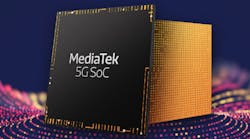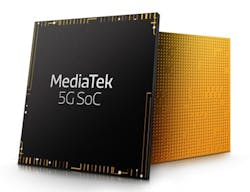Leveraging the latest CPU, GPU, and machine-learning (ML) hardware, MediaTek’s 7-nm, FinFET 5G chipset will target high-end smartphones (see figure). The platform incorporates MediaTek’s Helio M70 5G modem and Arm’s Cortex-A77 CPU cluster, the Arm Mali-G77 GPU, and MediaTek’s AI processing unit (APU).
MediaTek’s latest Helio chipset incorporates the Helio M70 5G modem and ARM’s Cortex-A77 CPU cluster, the ARM Mali-G77 GPU and MediaTek’s AI processing unit (APU).
MediaTek’s 5G modem supports 2.5-Gb/s upload and 4.7-Gb/s download speeds. Equipped with multimode support for 2G, 3G, 4G, and 5G networks, the modem can operate in standalone (SA) and non-standalone (NSA) mode networks and supports carrier aggregation. The chipset supports sub-6-GHz and 2.5-GHz bands, which could be a challenge for some carriers. The system will also have Wi-Fi and Bluetooth capability. The chip includes comprehensive power-management support with intelligent power-saving modes.
The chip is one of the first to use Arm’s quad-core Cortex-A77 CPU combined with the Mali-G77 GPU. The GPU can handle 80-Mpixel cameras with HDR support, as well as 4K video encode/decode streams at 60 frames/s. The system will support the open-source, Open Portable Trusted Execution Environment (OP-TEE).
Says MediaTek President Joe Chen, “Everything about this chip is designed for the first wave of flagship 5G devices. The leading-edge technology in this chipset makes it the most powerful 5G SoC announced to date and puts MediaTek at the forefront of 5G SoC design.”
The chipset will be available for sampling in Q3 of 2019, with production underway by Q1 of 2020.



